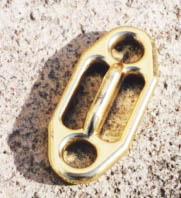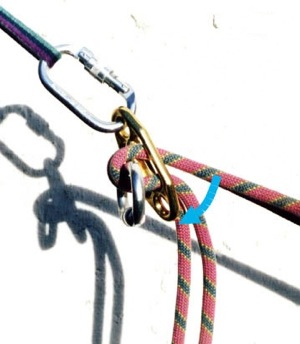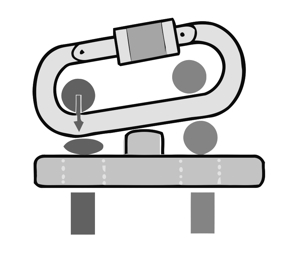It is self-locking plate belay device, designed for protection of the seconding climbers in rather easier terrains. The belay is only static, dynamic mode of belay is not possible, so it cannot be used for belaying the leader. It is made from a single piece of metal stamping and for it to work you need to have another carabiner, preferably oval locking carabiner. Company named Kong manufactures it under the name of Gi-gi, which also took as the most common name for this type of belay device. Similar device is also made by Cassin. Plate belay device can be used both for protection with single rope or two strand ropes (half rope, twin rope). It can belay both one seconding climber and two seconding climbers, when either of the seconds is tied to one strand of the rope. Therefore two climbers can climb at the same time, which significantly save time.

Belaying is performed by pulling the bight of the rope through the hole in the device and the carabiner is clipped into the created eye of the rope. It is necessary to lead the strand of the rope leading down to the second through the hole in the device us upper. Under the load must this upper rope strand pinch unto the bottom strand. Hangdogging second will cause the blocking of the rope in the device by its own weight. Therefore the belayer on the belay station does not have to permanently hold the dead part of the rope; all he/she must do is to retrieve the rope as the second climbs up.

But the self-blocking has its dark side. If the second will not be able to pass a difficult place and completely resigns on the climb, the belayer on the belay station cannot readily lower him/her down. The only way how to release blocking of loaded rope in the device is to lift carabiner clipped in rope’s bight. That can be done either by hand (very hard, almost impossible) or by webbing sling. Here is how to do it: from carabiner clipped through a rope’s bight we pull a webbing sling through another carabiner clipped in the belay station (i.e. above plate belay device). Belayer will clip the other end of the webbing sling to his/her seat harness and by sitting puts a load on it. That will lift the carabiner clipped on rope’s bight and release the blocking of the rope. It is a bit complicated, therefore is better to belay the second by this autoblocking method only in easy terrains, where in relation with his/her performance is not expected that he/she will have a problem with climbing.

Continued in the book >>

